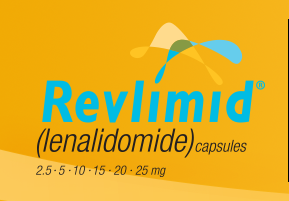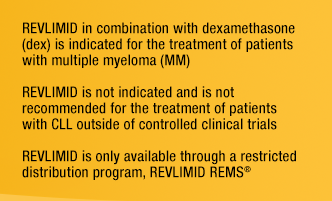Important Safety Information (continued)
CONTRAINDICATIONS
Pregnancy: REVLIMID can cause fetal harm when administered to a pregnant female and is contraindicated in females who are pregnant. If this drug is used during pregnancy or if the patient becomes pregnant while taking this drug, the patient should be apprised of the potential hazard to the fetus
Allergic Reactions: REVLIMID is contraindicated in patients who have demonstrated hypersensitivity (e.g., angioedema, Stevens-Johnson syndrome, toxic epidermal necrolysis) to lenalidomide
WARNINGS AND PRECAUTIONS
Embryo-Fetal Toxicity:
-
REVLIMID is an analogue of thalidomide, a known human teratogen that causes life-threatening human birth defects or embryo-fetal death. An embryo-fetal development study in monkeys indicates that lenalidomide produced malformations in offspring of female monkeys who received drug during pregnancy, similar to birth defects observed in humans following exposure to thalidomide during pregnancy
-
Females of Reproductive Potential: Must avoid pregnancy for at least 4 weeks before beginning REVLIMID therapy, during therapy, during dose interruptions and for at least 4 weeks after completing therapy. Must commit either to abstain continuously from heterosexual sexual intercourse or to use two methods of reliable birth control beginning 4 weeks prior to initiating treatment with REVLIMID, during therapy, during dose interruptions and continuing for 4 weeks following discontinuation of REVLIMID. Must obtain 2 negative pregnancy tests prior to initiating therapy
-
Males: Lenalidomide is present in the semen of patients receiving the drug. Males must always use a latex or synthetic condom during any sexual contact with females of reproductive potential while taking REVLIMID and for up to 28 days after discontinuing REVLIMID, even if they have undergone a successful vasectomy. Male patients taking REVLIMID must not donate sperm
-
Blood Donation: Patients must not donate blood during treatment with REVLIMID and for 1 month following discontinuation of the drug because the blood might be given to a pregnant female patient whose fetus must not be exposed to REVLIMID
REVLIMID REMS® Program
Because of embryo-fetal risk, REVLIMID is available only through a restricted program under a Risk Evaluation and Mitigation Strategy (REMS) the REVLIMID REMS® program (formerly known as the “RevAssist®” program). Prescribers and pharmacies must be certified with the program and patients must sign an agreement form and comply with the requirements. Further information about the REVLIMID REMS® program is available at www.celgeneriskmanagement.com or by telephone at 1-888-423-5436
Hematologic Toxicity: REVLIMID can cause significant neutropenia and thrombocytopenia. Monitor patients with neutropenia for signs of infection. Advise patients to observe for bleeding or bruising, especially with use of concomitant medications that may increase risk of bleeding. MM: Patients taking REVLIMID/dex should have their complete blood counts (CBC) assessed every 7 days for the first 2 cycles, on days 1 and 15 of cycle 3, and every 28 days thereafter.
Venous and Arterial Thromboembolism: Venous thromboembolic events (DVT and PE) and arterial thromboses are increased in patients treated with REVLIMID. A significantly increased risk of DVT (7.4%) and PE (3.7%) occurred in patients with MM after at least one prior therapy, treated with REVLIMID/dex compared to placebo/dex (3.1% and 0.9%) in clinical trials with varying use of anticoagulant therapies. In NDMM study, in which nearly all patients received antithrombotic prophylaxis, DVT (3.6%) and PE (3.8%) were reported in the Rd continuous arm. Myocardial infarction (MI, 1.7%) and stroke (CVA, 2.3%) are increased in patients with MM after at least 1 prior therapy who were treated with REVLIMID/dex therapy compared with placebo/dex (0.6%, and 0.9%) in clinical trials. In NDMM study, MI (including acute) was reported (2.3%) in the Rd Continuous arm. Frequency of serious adverse reactions of CVA was (0.8%) in the Rd Continuous arm. Patients with known risk factors, including prior thrombosis, may be at greater risk and actions should be taken to try to minimize all modifiable factors (e.g. hyperlipidemia, hypertension, smoking). In controlled clinical trials that did not use concomitant thromboprophylaxis, 21.5% overall thrombotic events occurred in patients with refractory and relapsed MM who were treated with REVLIMID/dex compared to 8.3% thrombosis in the placebo/dex group. Median time to first thrombosis event was 2.8 months. In NDMM study, which nearly all patients received antithrombotic prophylaxis, overall frequency of thrombotic events was 17.4% in combined Rd Continuous and Rd18 arms. Median time to first thrombosis event was 4.37 months. Thromboprophylaxis is recommended and regimen is based on patients underlying risks. ESAs and estrogens may further increase the risk of thrombosis and their use should be based on a benefit-risk decision. See Boxed WARNINGS
Increased Mortality in Patients With CLL: In a clinical trial in the first line treatment of patients with CLL, single agent REVLIMID therapy increased the risk of death as compared to single agent chlorambucil. In an interim analysis, there were 34 deaths among 210 patients on the REVLIMID treatment arm compared to 18 deaths among 211 patients in the chlorambucil treatment arm, and hazard ratio for overall survival was 1.92 [95% CI: 1.08-3.41] consistent with a 92% increase in risk of death. Serious adverse cardiovascular reactions, including atrial fibrillation, myocardial infarction, and cardiac failure, occurred more frequently in the REVLIMID treatment arm. REVLIMID is not indicated and not recommended for use in CLL outside of controlled clinical trials
Second Primary Malignancies: In clinical trials in patients with MM receiving REVLIMID, an increase of invasive second primary malignancies (SPM) notably AML and MDS have been observed. The increase of AML and MDS occurred predominantly in NDMM patients receiving REVLIMID in combination with oral melphalan (5.3%) or immediately following high dose intravenous melphalan and ASCT (up to 5.2%). The frequency of AML and MDS cases in the Revlimid/dex arms was observed to be 0.4%. Cases of B-cell malignancies (including Hodgkin’s Lymphomas) were observed in clinical trials where patients received REVLIMID in the post-ASCT setting. Patients who received REVLIMID-containing therapy until disease progression did not show a higher incidence of invasive SPM than patients treated in the fixed duration REVLIMID-containing arms. Monitor patients for the development of second primary malignancies. Take into account both the potential benefit of REVLIMID and risk of second primary malignancies when considering treatment
Hepatotoxicity: Hepatic failure, including fatal cases, has occurred in patients treated with Revlimid in combination with dex. The mechanism of drug-induced hepatotoxicity is unknown. Pre-existing viral liver disease, elevated baseline liver enzymes, and concomitant medications may be risk factors. Monitor liver enzymes periodically. Stop REVLIMID upon elevation of liver enzymes. After return to baseline values, treatment at a lower dose may be considered
Allergic Reactions: Angioedema and serious dermatologic reactions including Stevens-Johnson syndrome (SJS) and toxic epidermal necrolysis (TEN) have been reported. These events can be fatal. Patients with a prior history of Grade 4 rash associated with thalidomide treatment should not receive REVLIMID. REVLIMID interruption or discontinuation should be considered for Grade 2-3 skin rash. REVLIMID must be discontinued for angioedema, Grade 4 rash, exfoliative or bullous rash, or if SJS or TEN is suspected and should not be resumed following discontinuation for these reactions. REVLIMID capsules contain lactose. Risk-benefit of REVLIMID treatment should be evaluated in patients with lactose intolerance
Tumor Lysis Syndrome: Fatal instances of tumor lysis syndrome (TLS) have been reported during treatment with lenalidomide. The patients at risk of TLS are those with high tumor burden prior to treatment. These patients should be monitored closely and appropriate precautions taken
Tumor Flare Reaction: Tumor flare reaction (TFR) has occurred during investigational use of lenalidomide for CLL and lymphoma, and is characterized by tender lymph node swelling, low grade fever, pain and rash
Impaired Stem Cell Mobilization: A decrease in the number of CD34+ cells collected after treatment (> 4 cycles) with REVLIMID has been reported. In patients who are autologous stem cell transplant (ASCT) candidates, referral to a transplant center should occur early in treatment to optimize timing of the stem cell collection
ADVERSE REACTIONS
Multiple Myeloma
-
In newly diagnosed patients the most frequently reported Grade 3 or 4 adverse reactions in Arm Rd Continuous included neutropenia (27.8%), anemia (18.2%), thrombocytopenia (8.3%), pneumonia (11.3%), asthenia (7.7.%), fatigue (7.3%), back pain (7%), hypokalemia (6.6%), rash (7.3%), cataract (5.8%), dyspnea (5.6%), DVT (5.6%), hyperglycemia (5.3%), lymphopenia and leukopenia. The frequency of infections in Arm Rd Continuous was 75%
-
Adverse reactions reported in ≥20% of NDMM patients in Arm Rd Continuous: diarrhea (45.5%), anemia (43.8%), neutropenia (35%), fatigue (32.5%), back pain (32%), insomnia (27.6%), asthenia (28.2%), rash (26.1%), decreased appetite (23.1%), cough (22.7%), pyrexia (21.4%), muscle spasms (20.5%), and abdominal pain (20.5%). The frequency of onset of cataracts increased over time with 0.7% during the first 6 months and up to 9.6% by the second year of treatment with Arm Rd Continuous
-
After at least one prior therapy most adverse reactions and Grade 3 or 4 adverse reactions were more frequent in MM patients who received the combination of REVLIMID/dex compared to placebo/dex. Grade 3 or 4 adverse reactions included neutropenia 33.4% vs 3.4%, febrile neutropenia 2.3% vs 0%, DVT 8.2% vs 3.4% and PE 4% vs 0.9% respectively
Adverse reactions reported in ≥15% of MM patients (REVLIMID/dex vs dex/placebo): fatigue (44% vs 42%), neutropenia (42% vs 6%), constipation (41% vs 21%), diarrhea (39% vs 27%), muscle cramp (33% vs 21%), anemia (31% vs 24%), pyrexia (28% vs 23%), peripheral edema (26% vs 21%), nausea (26% vs 21%), back pain (26% vs 19%), upper respiratory tract infection (25% vs 16%), dyspnea (24% vs 17%), dizziness (23% vs 17%), thrombocytopenia (22% vs 11%), rash (21% vs 9%), tremor (21% vs 7%), weight decreased (20% vs 15%), nasopharyngitis (18% vs 9%), blurred vision (17% vs 11%), anorexia (16% vs 10%), and dysgeusia (15% vs 10%)
DRUG INTERACTIONS
Periodic monitoring of digoxin plasma levels, in accordance with clinical judgment and based on standard clinical practice in patients receiving this medication, is recommended during administration of REVLIMID. It is not known whether there is an interaction between dex and warfarin. Close monitoring of PT and INR is recommended in MM patients taking concomitant warfarin. Erythropoietic agents, or other agents, that may increase the risk of thrombosis, such as estrogen containing therapies, should be used with caution after making a benefit-risk assessment in patients receiving REVLIMID
USE IN SPECIFIC POPULATIONS
Pregnancy: If pregnancy does occur during treatment, immediately discontinue the drug. Under these conditions, refer patient to an obstetrician/gynecologist experienced in reproductive toxicity for further evaluation and counseling. Any suspected fetal exposure to REVLIMID must be reported to the FDA via the MedWatch program at 1-800-332-1088 and also to Celgene Corporation at 1-888-423-5436
Nursing Mothers: It is not known whether REVLIMID is excreted in human milk. Because many drugs are excreted in human milk and because of the potential for adverse reactions in nursing infants, a decision should be made whether to discontinue nursing or the drug, taking into account the importance of the drug to the mother
Pediatric Use: Safety and effectiveness in patients below the age of 18 have not been established
Renal Impairment: Since REVLIMID is primarily excreted unchanged by the kidney, adjustments to the starting dose of REVLIMID are recommended to provide appropriate drug exposure in patients with moderate (CLcr 30-60 mL/min) or severe renal impairment (CLcr < 30 mL/min) and in patients on dialysis
Please click for full Prescribing Information, including Boxed WARNINGS.
Reference:
1. REVLIMID [package insert]. Summit, NJ: Celgene Corporation. 2015.




